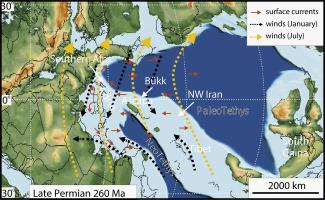Geoscience Frontiers ( IF 8.9 ) Pub Date : 2020-11-03 , DOI: 10.1016/j.gsf.2020.09.021 M.E. Brookfield , J.C. Williams , A.G. Stebbins

|
The Bálvány North Permian-Triassic boundary sediments were deposited on a carbonate platform in the tropical part of the western PaleoTethys ocean. The overall elemental geochemistry of the detailed two-metre-thick section across the boundary that we studied shows that the clastic content of the sediments came from dominantly silica-rich continental sources though with some more silica-poor inputs in the uppermost Permian and lowest Triassic limestones as shown by Ni/Al and Nb/Ta ratios. These inputs bracket, but do not coincide with, the main extinctions and associated C, O and S changes. Increased aridity at the Permian-Triassic boundary with increased wind abrasion of suitable Ti-bearing heavy minerals accounts for both the high Ti/Al and Ti/Zr ratios. Various geochemical redox proxies suggest mainly oxic depositional conditions, with episodes of anoxia, but with little systematic variation across the Permian–Triassic extinction boundary. The lack of consistent element geochemical changes across the Permian-Triassic boundary occur not only in adjacent shallower-water marine sections, and in other marine sections along the SW Tethys margin such as the Salt Range sections in Pakistan, but also in deeper shelf and oceanic sections, and in non- marine African and European continental sediments. In the absence of significant changes in physical environments, chemical changes in the atmosphere and oceans, reflected in various isotopic changes, drove the Permian–Triassic extinctions.
中文翻译:

匈牙利Bűkk山脉上一个连续的二叠系-三叠纪边界段的古环境和地球化学
Bálvány北二叠纪-三叠纪边界沉积物沉积在古特提斯洋西部热带地区的碳酸盐台地上。我们研究的边界上两米厚的详细剖面的整体元素地球化学表明,沉积物中的碎屑含量主要来自富含二氧化硅的大陆来源,尽管在最高的二叠纪和最低的三叠纪有少量的贫硅输入。如Ni / Al和Nb / Ta比所示的石灰石。这些输入支持但不与主要的灭绝事件以及相关的C,O和S变化一致。较高的Ti / Al和Ti / Zr比率都表明,二叠系-三叠纪边界的干旱增加,而合适的含Ti重矿物的风磨损增加。各种地球化学氧化还原代理主要表明有氧沉积条件,伴有缺氧发作,但在二叠纪-三叠纪灭绝边界上几乎没有系统变化。不仅在相邻的浅水海域以及西南特提斯边缘的其他海域(如巴基斯坦的盐岭海域),而且在二叠纪-三叠纪边界都缺乏一致的元素地球化学变化。剖面以及非海洋的非洲和欧洲大陆沉积物中。在没有明显的物理环境变化的情况下,反映在各种同位素变化中的大气和海洋化学变化推动了二叠纪-三叠纪的灭绝。不仅在相邻的浅水海域以及西南特提斯边缘的其他海域(如巴基斯坦的盐岭海域),而且在二叠纪-三叠纪边界都缺乏一致的元素地球化学变化。剖面以及非海洋的非洲和欧洲大陆沉积物中。在物理环境没有明显变化的情况下,大气和海洋的化学变化(反映在各种同位素变化中)促使二叠纪-三叠纪灭绝。不仅在相邻的浅水海域以及西南特提斯边缘的其他海域(如巴基斯坦的盐岭海域),而且在二叠纪-三叠纪边界都缺乏一致的元素地球化学变化。剖面以及非海洋的非洲和欧洲大陆沉积物中。在没有明显的物理环境变化的情况下,反映在各种同位素变化中的大气和海洋化学变化推动了二叠纪-三叠纪的灭绝。


























 京公网安备 11010802027423号
京公网安备 11010802027423号